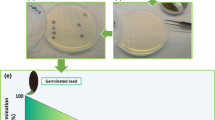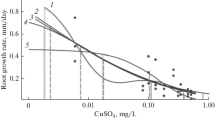Abstract
The quality of seed progeny was studied in Plantago major from populations growing for a long time in the gradient of chemical pollution around the Karabash Copper Smelter (KCS). The results showed that the range of variation in seed germination and seedling survival rates was wider in background than in impact populations. The lowest values of growth parameters (the number of seedlings with a true leaf and root length) were recorded in the sample from the most polluted plot. Challenging exposure to toxic elements (seed germination in soils from polluted plots) was found to stimulate, to different extents, the rate of leaf formation and suppress root growth in the seedlings. It cannot be stated from these results that the adaptive potential of plants grown in the zone of impact from the KCS is altered, compared to that in other samples. Evaluation of the prooxidant and antioxidant status of seedlings from this zone revealed a decrease in superoxide dismutase and catalase activities (to 60 and 33% of background values, respectively) and an increase in peroxidase activity (to 122%). The prooxidant status of seedlings in samples from the KCS zone was found to be increased, except for the sample from the most polluted plot.
Similar content being viewed by others
References
Cox, R.M., Air pollution effects on plant reproductive processes and possible consequences to their population biology, in Air Pollution Effects on Biodiversity, Barker, J.R. and Tingey, D.T., Eds., New York: Van Nostrand Reinhold, 1992, pp. 131–158.
Pozolotina, V.N., Antonova, E.V., and Bezel, V.S., Comparison of remote consequences in Taraxacum officinale seed progeny collected in radioactively or chemically contaminated areas, Ecotoxicology, 2012, vol. 21, no. 7, pp. 1979–1988.
Titov, A.F., Kaznina, N.M., and Talanova, V.V., Tyazhelye metally i rasteniya (Heavy Metals and Plants), Petrozavodsk: Karel. Nauch. Tsentr Ross. Akad. Nauk, 2014.
Pozolotina, V.N., Antonova, E.V., and Shimalina, N.S., Adaptation of greater plantain, Plantago major L., to long term radiation and chemical exposure, Russ. J. Ecol., 2016, vol. 47, no. 1, pp. 1–10. doi 10.1134/S1067413616010124
Zvereva, E.L., Roitto, M., and Kozlov, M.V., Growth and reproduction of vascular plants in polluted environments: A synthesis of existing knowledge, Environ. Rev., 2010, vol. 18, pp. 355–367. doi 10.1139/A10-017
Elkarmi, A. and Eideh, A.R., Allometry of Urtica urens in polluted and unpolluted habitats, J. Plant Biol., 2006, vol. 49, no. 1, pp. 9–15. doi 10.1007/BF03030783
Calabrese, E.J., Hormesis: Why it is important to toxicology and toxicologists, Environ Toxicol. Chem., 2008, vol. 27, pp. 1451–1474. doi 10.1897/07-541
Erofeeva, E.A., Hormesis and paradoxical effects of wheat seedling (Triticum aestivum L.) parameters upon exposure to different pollutants in a wide range of doses, Dose Response, 2014, vol. 12, pp. 121–135.
Sharma, P., Jha, A.B., Dubey, R.S., and Pessarakli, M., Reactive oxygen species, oxidative damage, and antioxidative defense mechanism in plants under stressful conditions, J. Bot., 2012, vol. 2012, pp. 1–26. doi 10.1155/2012/217037
Chirkova, T.V., Fiziologicheskie osnovy ustoichivosti rastenii (Physiological Bases of Plant Hardiness), St. Petersburg: S.-Peterb. Gos. Univ., 2002.
Fang, W.C., Enhanced peroxidase activity in rice leaves in response to excess iron, copper, and zinc, Plant Sci., 2000, vol. 158, pp. 71–76.
Devi, S.R. and Prasad, M.N.V., Antioxidant capacity of Brassica juncea plants exposed to elevated levels of copper, Russ. J. Plant Physiol., 2005, vol. 52, no. 2, pp. 205–208.
Sanchez-Pardo, B., Fernandes-Pascual, M., and Zornoza, P., Copper microlocalization and changes in leaf morphology, chloroplast ultrastructure and antioxidative response in white lupin and soybean grown in copper excess, J. Plant Res., 2014, vol. 127, pp. 119–129. doi 10.1007/s10265-013-0581-1
Pozolotina, V. and Antonova, E., Temporal variability of the quality of Taraxacum officinale seed progeny from the East-Ural radioactive trace: Is there an interaction between low level radiation and weather conditions?, int. J. Radiat. Biol., 2017, vol. 93, no. 3, pp. 330–339.
Bezel’, V.S., Pozolotina, V.N., Bel’skii, E.A., and Zhuikova, T.V., Variation in population parameters: Adaptation to toxic environmental factors, Russ. J. Ecol., 2001, vol. 32, no. 6, pp. 413–419.
Ontogeneticheskii atlas lekarstvennykh rastenii (Ontogenetic Atlas of Medicinal Plants), vol. 1, Zhukova, L.A., Ed., Ioshkar-Ola: Mariisk. Gos. Univ., 1997, pp. 121–132.
Kompleksnaya ekologicheskaya otsenka tekhnogennogo vozdeistviya na ekosistemy yuzhnoi taigi (Integrated Ecological Assessment of Technogenic Impact on Southern Taiga Ecosystems), Stepanov, A.M., Ed., Moscow: TsEPL, 1992.
Chernen'kova, T.V., Reaktsiya lesnoi rastitel’nosti na promyshlennoe zagryaznenie (Response of Forest Vegetation to Industrial Pollution), Moscow: Nauka, 2002.
Smorkalov, I.A. and Vorobeichik, E.L., Soil respiration of forest ecosystems in gradients of environmental pollution by emissions from copper smelters, Russ. J. Ecol., 2011, vol. 42, no. 6, pp. 464–470.
Kaigorodova, S.Yu., Transformation of soil morphology in the zone of impact from the Karabash Copper Smelter, Vestn. Orenburg. Gos. Univ., 2012, no. 6, pp. 13–17.
Ermakov, A.I., Arasimovich, V.V., and Yarosh, N.P., Metody biokhimicheskogo issledovaniya rastenii (Methods of Biochemical Analysis of Plants), Leningrad: Agropromizdat, 1987.
Buege, J.A. and Aust, S.D., Microsomal lipid peroxidation, in Methods in Enzymology, vol. 52, Fleischer, S. and Packer, L., Eds., New York: Academic Press, 1978, pp. 302–310.
Kruger, N.J., The Bradford method for protein quantitation, in The Protein Protocols Handbook, Walker, J.M., Ed., New York: Humana Press, 2002, pp. 15–21.
Giannopolitis, C.N. and Ries, S.K., Superoxide dismutases: 1. Occurrence in higher plants, Plant Physiol., 1977, vol. 59, no. 2, pp. 309–314.
Góth, L., A simple method for determination of serum catalase activity and revision of reference range, Clin. Chim. Acta, 1991, vol. 196, pp. 143–152.
Popov, T. and Neikovska, L., A method for determining blood peroxidase activity, Gig. Sanit., 1971, no. 10, pp. 89–91.
Newcombe, R.G., Interval estimation for the difference between independent proportions: Comparison of eleven methods, Stat. Med., 1998, vol. 17, no. 8, pp. 873–890.
Galat, T.M. and Shehata, H.S., Bioaccumulation and translocation of heavy metals by Plantago major L. grown in contaminated soils under the effect of traffic pollution, Ecol. Indic., 2015, vol. 48, pp. 244–251.
Prokop’ev, I.A., Zhuravskaya, A.N., and Filippova, G.V., Variability of biochemical parameters and radiation resistance of the seed progeny of Descurainia sophia and Lepidium apetalum under exposure to various factors, Russ. J. Ecol., 2011, vol. 42, no. 4, pp. 277–282.
Antonova, E.V., Karimullina, E.M., and Pozolotina, V.N., Intraspecific variation in Melandrium album along a radioactive contamination gradient at the Eastern Ural Radioactive Trace, Russ. J. Ecol., 2013, vol. 44, no. 1, pp. 18–27. doi 10.1134/S1067413613010025
Antonova, E.V., Pozolotina, V.N., and Karimullina, E.M., Variation in the seed progeny of smooth brome grass, Bromus inermis Leyss., under conditions of chronic irradiation in the zone of the Eastern Ural Radioactive Trace, Russ. J. Ecol., 2014, vol. 45, no. 6, pp. 508–516. doi 10.1134/S1067413614060034
Bruce, T.J.A., Matthes, M.C., Napier, J.A., and Pickett, J.A., Stressful ''memories'' of plants: Evidence and possible mechanisms, Plant Sci., 2007, vol. 173, pp. 603–608.
Maternal Effects As Adaptations, Mousseau, T.A. and Fox, C.W., Eds., Oxford, UK: Oxford Univ. Press, 1998.
Galloway, L.F., Maternal effects provide phenotypic adaptation to local environmental conditions, New Phytol., 2005, vol. 166, no. 1, pp. 93–99.
Boyko, A. and Kovalchuk, I., Genome instability and epigenetic modification: Heritable responses to environmental stress?, Curr. Opin. Plant Biol., 2011, vol. 14, no. 3, pp. 260–266.
Polesskaya, O.G., Rastitel’naya kletka i aktivnye formy kisloroda (Plant Cell and Reactive Oxygen Species), Moscow: Universitet, 2007.
Lutova, L.A., Ezhova, T.A., Dodueva, I.E., and Osipova, M.A., Genetika razvitiya rastenii (Genetics of Plant Development), St. Petersburg: Izd. N-L, 2010.
Ahmad, P., Sarwat, M., and Sharma, S., Reactive oxygen species, antioxidants and signaling in plants, J. Plant Biol., 2008, vol. 51, no. 3, pp. 167–173.
Veselova, T.V., Veselovskii, V.A., and Chernavskii, D.S., Stress u rastenii (Stress in Plants), Moscow: Mosk. Gos. Univ., 1993.
Raychaudhuri, S.S. and Deng, X., W. The role of SOD in combating oxidative stress in higher plants, Bot. Rev., 2000, vol. 66, no. 1, pp. 89–98.
Alscher, R.G., Erturk, N., and Heath, L.S., Role of superoxide dismutases (SODs) in controlling oxidative stress in plants, J. Exp. Bot., 2002, vol. 53, no. 372, pp. 1331–1341.
Ogawa, K., Kanematsu, S., and Asada, K., Intra- and extra-cellular localization of “cytosolic” CuZn-superoxide dismutase in spinach leaf and hypocotyls, Plant Cell Physiol., 1996, vol. 37, pp. 790–799.
Gazaryan, I.G., Khushpul’yan, D.M., and Tishkov, V.I., Specific features in the structure and action mechanism of plant peroxidases, Usp. Biol. Khim., 2006, vol. 46, pp. 303–322.
Almagro, L., Gomez Ros, L.V., Belchi-Navarro, S., et al., Class III peroxidases in plant defense reactions, J. Exp. Bot., 2009, vol. 60, no. 2, pp. 377–390.
Author information
Authors and Affiliations
Corresponding author
Additional information
Original Russian Text © N.S. Shimalina, V.N. Pozolotina, N.A. Orekhova, E.V. Antonova, 2017, published in Ekologiya, 2017, No. 6, pp. 420–430.
Rights and permissions
About this article
Cite this article
Shimalina, N.S., Pozolotina, V.N., Orekhova, N.A. et al. Assessment of biological effects in Plantago major L. Seed progeny in the zone of impact from a Copper Smelter. Russ J Ecol 48, 513–523 (2017). https://doi.org/10.1134/S1067413617060108
Received:
Published:
Issue Date:
DOI: https://doi.org/10.1134/S1067413617060108




